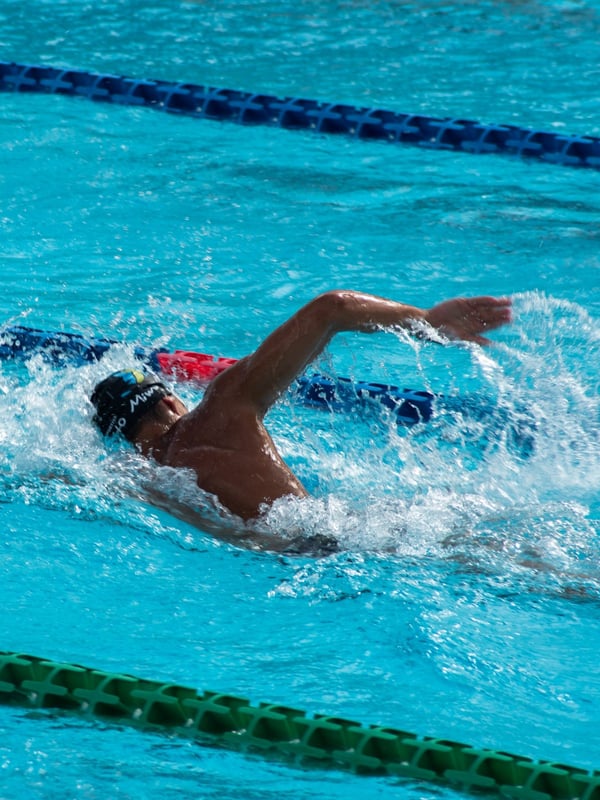
As a strength and conditioning coach or fitness professional today, it’s likely we spend most of our days inside a dark, dust-filled weight room training our athletes to move and perform at a higher level to the sounds of Metallica and clanging iron (and I’m into it). But sometimes the best thing we can do is escape the cage and get outside for some variety and a change of scenery to help break the mold. Pool workouts have been a go-to for a lot of people for a multitude of reasons, but is it really helping us move closer to the end goal of moving more efficiently?
Swimming is like riding a bike for most people. You could argue that it’s “good for the soul” and puts a smile on our face while we get the heart rate up. After all, sometimes you just need to minimize the impact on the joints and stress the system just enough in order to get back in the training facility to hit it hard again. While there can be benefits to a circulatory response in order to promote healing and tissue recovery there is just so much we don’t know about the impact (or lack of) on our athletes to be prescribing it frequently.
As mentioned above we know that swimming can be used as a recovery tool to maintain fitness levels at low impact. Being a full-body exercise, swimming is great for recruiting all muscle groups and pushing (nutrient-filled) blood around promote active recovery and adaptation. Returning from injury is a time when we need to minimize the forces on the body so there is merit in providing light resistance to the system. Most of all, swimming outside is fun and that can’t be overlooked. The mental stress on an individual trying to improve or prepare for a competitive season can be taxing so providing an outlet to boost endorphin production and improve mood can’t be understated.
With most training prescriptions we have a good understanding from the research what loading will elicit desired adaptations. With swimming, most every “workout” varies exponentially based on feel. Just as a pitcher works in the bullpen on his cutter “until it’s right” there are often times we exceed the volume “sweet spot” and do more harm than good turning a light recovery day into much more. At the end of the day, we know much less about dosage with swimming and nearly everyone is doing it differently.
Pool workouts aren’t called training for a reason. Training and working out are two different things. Completely random workouts aren’t likely to improve specific qualities we are after, and can sometimes make force asymmetries (eccentric vs concentric rate of force) worse. We’ve seen activities like biking and distance running have a harmful effect on movement sequencing, and swimming can fall in the same category if not careful.
In our aggregated database of over one million scans, we have a vast amount of aquatic athletes. The consistent trend we see in aquatics is high Drive (concentric impulse), which is beneficial for a swimmer given they need to prolong force for longer periods with each stroke in the pool. Instead of depending on quick-twitch force creation, the aquatic athlete relies on momentum and longer strokes to maximize swimming economy. The qualities needed in swimming are much different than the qualities needed for quick burst individuals.
If an athlete tends to rely on momentum to produce force, which is common in younger untrained athletes and longer lax individuals, we probably shouldn’t be prescribing pool workouts that enhance that quality further. Instead, we should be interested in improving weaknesses in their sequencing by addressing the ability to create and transfer force (Load and Explode). To do this, we’ve seen short, heavy movements work very well – not the opposite.
On the other hand, individuals that have a Lateral Scan, or higher Load and Explode with lower Drive it may be more beneficial to add swimming. We have found these individuals to lack fluidity in part because they are too bound up (creating force not an issue), which is where swimming may actually benefit this type of mover (in theory). That being said, swimming wouldn’t be the first intervention on the list to improve duration of force (impulse), but it would definitely make more sense for this type of individual.
Improving force production is hard enough, but when you add in a stimulus concurrently (such as distance running, biking or swimming) it makes it even harder to obtain. Everything that we do has an effect on the body – EVERYTHING. So when prescribing something to our athletes we must be cognizant of the impact it has on movement. At the end of the day, individuals that move more efficiently have shown lower rates of injury, therefore, prescribing exercises based on subjective feel and less objectivity can do more harm than good.